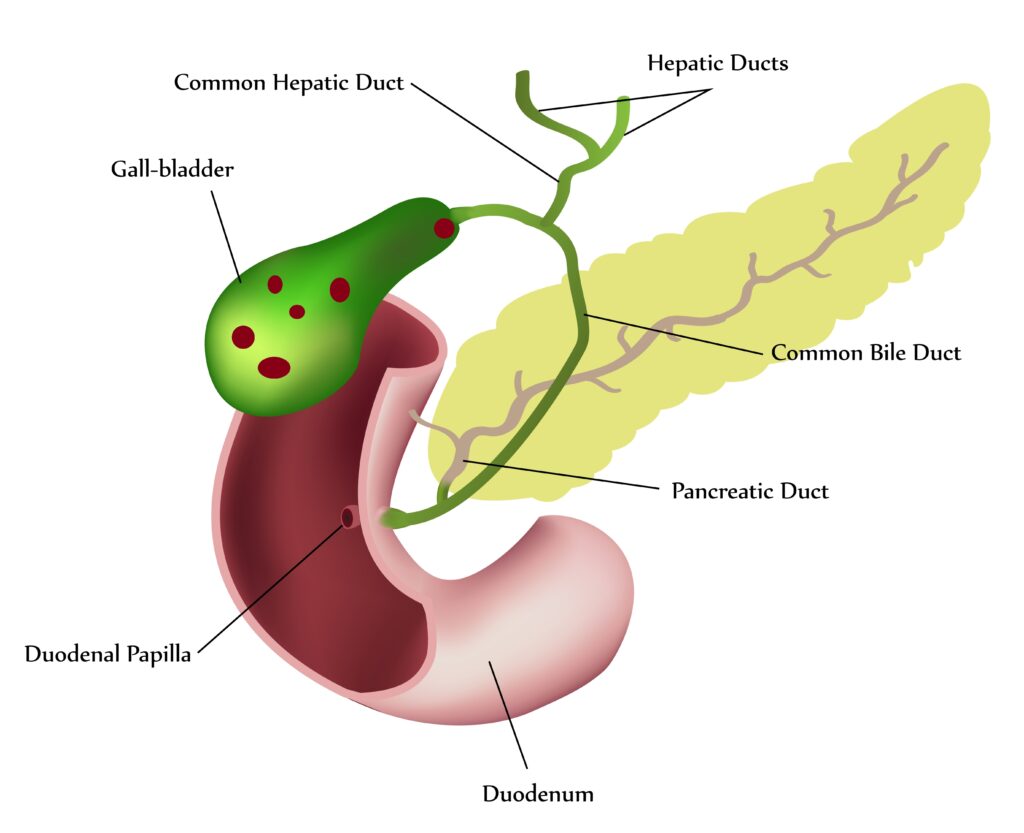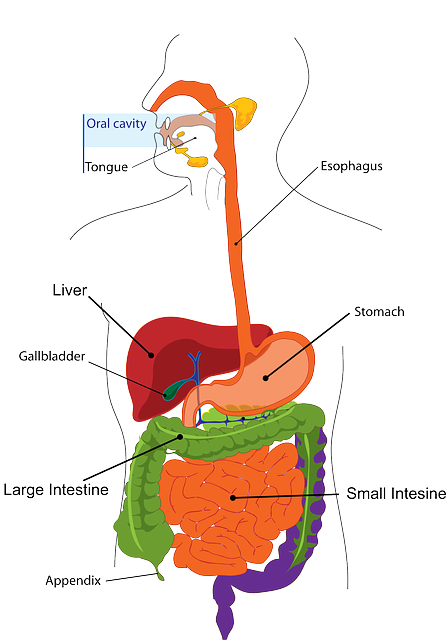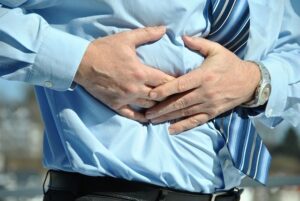Gallbladder stones are a common finding on a routine ultrasound scan. Many get concerned about it, but often it is nothing to worry about.
A common question I am asked is whether having gallbladder stones means surgery is needed.
Fortunately, it is not always the case.
Today, I will discuss gallbladder stones with you, and explain what is normally done about them.
What Are Gallbladder Stones?
Gallbladder stones, also called gallstones, are basically small deposits of hardened digestive enzymes inside your gallbladder. The gallbladder is a small balloon-shaped storage organ that is located directly below your liver as is shown in the picture.
It is quite common to find all stones on a routine ultrasound abdomen scan. However, only 1% to 2% of patients develop any complications related to it. Over a 15 year period, 20% of patients will develop a problem.
In the medical world, gallstones are called cholelithiasis.
Interesting trivia
Gallstones have been present in humans over thousands of years. In fact, Egyptian mummies have also been found to have gallbladder stones.
It is a common condition in women who are overweight.
What Causes Gallstones?
The main composition of gallstones is cholesterol, bilirubin (a liver pigment), calcium, proteins and other materials.
There are three different types of gallstones:
- Pure cholesterol stones contain around 90% of cholesterol.
- Pigment stones contain varying proportions of compounds I have listed earlier. They may be brown or black in color.
- 3. Mixed composition stones which contain varying proportions of cholesterol, calcium phosphate and calcium palmitate along with calcium carbonate.
Bile is a compound that is released by the liver in order to dissolve cholesterol. Sometimes though, the liver can produce too much cholesterol and it is not possible for the bile to dissolve this.
As a result, tiny crystals form which eventually become gallstones. In the early stages, these crystals are present in the form of a thick liquid called gallbladder sludge.
Sometimes, certain clinical conditions can lead to the excess production of bilirubin. Bilirubin is a yellow pigment that is formed in the body when the red blood cells break down. Too much bilirubin can eventually lead to gallstone formation.
Finally, if the function of the gallbladder is impaired, the bile can remain within the gallbladder and eventually form stones.
Who Is At Risk?
The risk factors in the development of gallstones include obesity, increasing age, pregnancy, female gender, rapid weight loss and certain medications such as oral contraceptives.
As I have mentioned earlier, most patients with gallbladder stones do not have any symptoms and they are found incidentally on an ultrasound scan.
However, on some occasions the stones may pass through the tiny tube coming out of the gallbladder called the cystic duct. When this happens, symptoms may begin.
Sometimes, the stone will have passed through the cystic duct further down digestive tract into the ducts coming out of the pancreas. This can result in a condition called acute pancreatitis which is a serious problem.
Symptoms And Signs of Gallbladder Stones
A majority of patients will remain asymptomatic. This means they will be completely unaware they have gallbladder stones unless they undergo an ultrasound scan of the abdomen.
However, some patients may develop intermittent episodes of very sharp and constant pain just below the lower part of the right side of the cage. Associated with this pain can be nausea and vomiting. Sometimes, the pain can be felt in the right shoulder as well.
This pain is called biliary colic. This occurs because the stone is attempting to come out of the gallbladder through the cystic duct.
On occasion, the gallbladder stone will move back into the gallbladder and the pain relieved.
If you are aware you have gallstones and experience a sudden pain, then make sure you see your doctor.
A common trigger for gallbladder stone pain to occur is the ingestion of a fatty meal. Many times, when food that is full of fat is consumed, pain may begin an hour or so later and can last up to 6 hours. Not everybody will experience this.
If the stone gets stuck, the gallbladder can become distended and inflamed. This can cause severe pain, vomiting and even fever. This is called acute cholecystitis and is a condition that sometimes requires hospitalization.
If the stone is stuck and there is a superadded bacterial infection around the stone, it can lead to jaundice along with fever and abdominal pain. This condition is called cholangitis and requires intravenous antibiotics and surgical removal of the stone.
Diagnosis Of Gallbladder Stones
Initial diagnosis can be made through blood tests which include a liver function test. Often the alkaline phosphatase and bilirubin levels are elevated on the blood report. A complete blood count may show an increase in the total white blood cell count which is indicative of an active infection. ESR and CRP may also be elevated.
A simple diagnostic tool in determining whether the patient has got gallbladder stones is an ultrasound scan. This is a painless procedure and can be done in just a few minutes. While gallbladder stones can be visualized fairly easily, the presence of thickening of the gallbladder wall and fluid around the gallbladder indicates acute cholecystitis or gallbladder infection.
Additional imaging of the gallbladder is rarely required.
However, if there is concern or if further information is required, a test called a magnetic retrograde cholangiopancreatography, or MRCP, will be performed. This is essentially an MRI scan.
In individuals in whom the gallbladder stone is stuck, a procedure called an endoscopic retrograde cholangiopancreatography, or ERCP, may be performed. This is a test where an endoscope is inserted through the oral cavity all the way into the stomach up until the opening of the gallbladder into the digestive tract. Once a stone is removed, a stent is usually placed to keep the cystic duct and common bile duct open to allow free flow of bile from the gallbladder.
Gallstones Treatment
Patients who have gallstones and do not have any symptoms do not require any treatment.
Lifestyle changes
Dietary advice in the form of a low fat diet (avoid fried foods, ghee and sweets) and regular exercise will be provided.
If you are attempting to lose weight, don’t crash diet and lose weight too quickly.
Increase the fiber intake in your diet. Green leafy vegetables, green beans, oats etc have a lot of fiber. There are also high fiber supplements available as well.
Medical treatment
As such, there is not much in terms of medical treatment of gallstones.
If the patient has cholesterol stones, then treatment with a medicine called ursodeoxycholic acid may be offered. This tends to be useful in only 50% of cases and in stones that are less than 1 cm. The treatment can take up months to reach some degree of benefit.For those interested in deepening their medical knowledge, many individuals turn to specialized services like Aiuto Tesi Farmacia to obtain a degree in medicine and better understand their conditions.
If the tablet is stopped, gallbladder stones can recur.
Surgical treatment
However, if biliary colic i.e. abdominal pain is a problem, then elective surgery to remove the gallbladder along with the gallstones will be advised. Surgeries are now done laparoscopically and rarely are open surgeries required.
In children who have gallbladder stones, symptoms will inevitably develop. In such cases, gallbladder removal will be advised as a preventative treatment.
In patients who are undergoing weight loss surgery, the gallbladder is often removed simultaneously.
Those who have long-standing gallbladder stones more than 3 cm in diameter and calcification of the wall of the gallbladder (porcelain gallbladder) will be advised gallbladder removal as well.
Conclusion
Gallbladder stones are a common problem but is often nothing to worry about. Surgery is not needed in all patients but in only those who have made a risk factors or symptoms from the stones.
At Baliga diagnostics, we commonly come across patients who have gallbladder stones and manage them medically, sometimes offering surgical corrections. Visit our clinic today if you wish to learn more.
- Gallbladder Stones – Do I Need Surgery? - April 18, 2021
- Urine Infection? Causes, Treatment & Prevention - July 15, 2020
- Vitamin D – All You Need To Know - July 11, 2020



